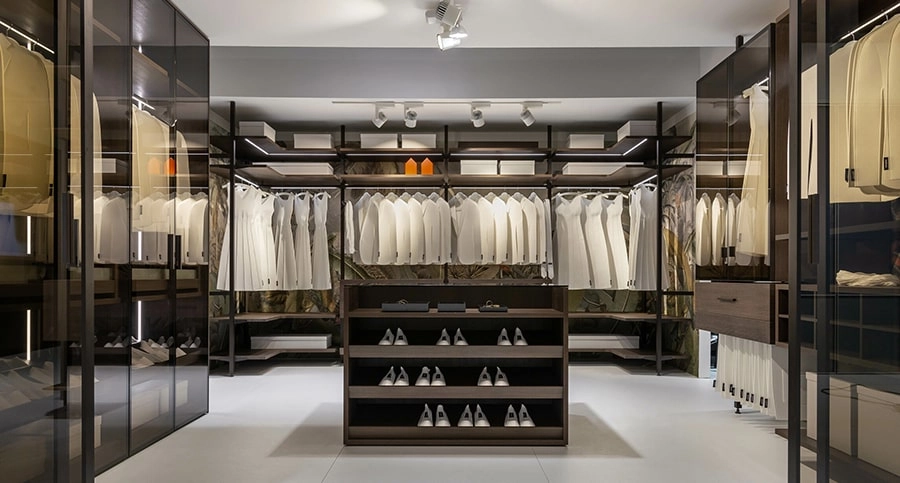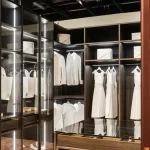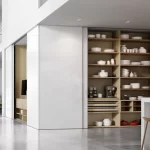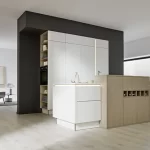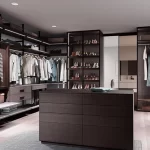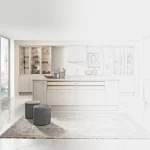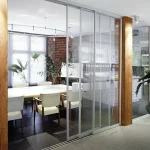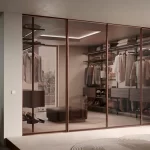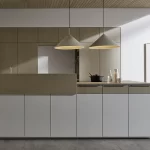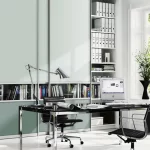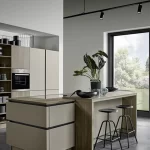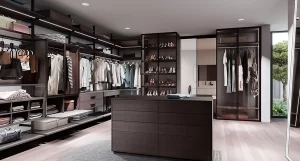Introduction:
Beyond mere storage spaces, walk-in closets have become personal sanctuaries where style meets organisation. This blog will guide you through the different types of walk-in closets, offer design ideas for various sizes, delve into the planning process, and help you infuse your personality into every corner.
Types of Walk-In Closets:
Reach-In Closets:
Ideal for smaller spaces, reach-in closets maximise vertical storage with shelves and rods.
L-Shaped Walk-In Closets:
Utilise two walls to create a versatile space, offering distinct sections for clothing, shoes, and accessories.
U-Shaped Walk-In Closets:
Surrounded by storage, U-shaped closets provide ample room for various organisational elements.
Island Walk-In Closets:
Central islands become focal points, offering additional storage and functional surfaces.
You may like to read this: Closet Systems Unveiled: A Comprehensive Guide to Choosing the Perfect Closet for Your Home
Designing Your Walk-In Closet:
Your walk-in closet should be an extension of your personality. Select colors, materials, and designs that align with your personal aesthetic. Explore different room concepts such as modern, minimal, industrial, or luxurious. Each concept offers a unique aesthetic that can define your space.
When it comes to walk-in closet design styles, there are numerous options to choose from, ranging from classic to contemporary. The choice often depends on your personal taste, the overall aesthetic of your home, and the level of customization you desire. Here are some popular design styles for walk-in closets:
Classic Elegance:
- Features: Rich wood finishes, ornate detailing, and classic furniture pieces.
- Colour Palette: Warm and neutral tones such as deep browns, creams, and gold accents.
- Furniture: Traditional wooden dressers, ornate mirrors, and upholstered seating.
Modern Minimalism:
- Features: Clean lines, sleek finishes, and minimalistic hardware.
- Colour Palette: White, black, and neutral tones with occasional pops of colour.
- Furniture: Simple shelving, open racks, and unadorned furniture pieces.
Industrial Chic:
- Features: Exposed brick, metal accents, and a utilitarian aesthetic.
- Colour Palette: Neutral tones with industrial elements like steel and distressed wood.
- Furniture: Metal clothing racks, wire baskets, and open shelving.
Luxurious Glamour:
- Features: Plush fabrics, mirrored surfaces, and crystal or gold accents.
- Colour Palette: Jewel tones, blacks, and whites with metallic accents.
- Furniture: Mirrored dressers, chandeliers, and velvet seating.

Scandinavian Simplicity:
- Features: Light wood tones, clean lines, and functional design.
- Colour Palette: White, light grey, and natural wood tones.
- Furniture: Minimalistic shelves, open clothing racks, and simple seating.
Rustic Charm:
- Features: Reclaimed wood, natural textures, and vintage elements.
- Colour Palette: Earthy tones such as browns, greens, and muted blues.
- Furniture: Wooden crates, vintage trunks, and distressed wood furniture.
Transitional Blend:
- Features: A fusion of classic and modern components.
- Colour Palette: Neutral tones with subtle pops of colour.
- Furniture: Classic furniture pieces mixed with modern storage solutions.
Contemporary Cool:
- Features: Innovative storage solutions, bold patterns, and unique lighting.
- Colour Palette: Vibrant colours or monochromatic schemes with bold accents.
- Furniture: Abstract shelving, modular storage, and unconventional furniture shapes.
Eclectic Mix:
- Features: A mix of styles, patterns, and textures for a unique, personalised look.
- Colour Palette: Diverse colour combinations and patterns.
- Furniture: An eclectic mix of vintage and modern furniture pieces.
Smart and Tech-Savvy:
- Features: Integrated technology, smart lighting, and automated storage solutions.
- Colour Palette: Neutral tones with futuristic metallic accents.
- Furniture: High-tech storage systems, LED-lit shelves, and smart mirrors.
You may like to read this: Streamlined Elegance and Smart Space Management: The Advantages of Sliding Doors and Sliding Door Closets
Planning Your Walk-In Closet Design:
A well-designed walk-in closet is more than just a luxury; it’s a practical and impactful addition to any home. Here are several reasons highlighting the importance of having a well-designed walk-in closet:
Organization and Efficiency:
The primary purpose of a walk-in closet is to provide organised storage. A well-designed closet maximises space and offers efficient storage solutions, making it easy to find and access clothing, shoes, accessories, and other items. This organisation saves time and reduces daily stress.
Increased Property Value:
A thoughtfully designed walk-in closet adds value to your home. Potential buyers often see a well-organised and visually appealing walk-in closet as a desirable feature, contributing to the overall appeal of the property.
Personalised Space:
Your walk-in closet is a reflection of your personal style. A well-designed closet allows for customization, enabling you to showcase your wardrobe, accessories, and personal items in a way that resonates with your taste and lifestyle.
Streamlined Morning Routine:
A well-organised closet contributes to a smoother morning routine. With designated spaces for different items, you can easily locate what you need, helping you start your day on a positive note without the stress of searching for misplaced belongings.
Preservation of Clothing and Accessories:
Adequate storage solutions in a well-designed walk-in closet help preserve the condition of your clothing and accessories. Proper hanging, folding, and storage prevent wrinkles, damage, and wear, prolonging the life of your wardrobe.
You may like to read this: Top Closet Supplier in Toronto: Quality, Style, and Functionality
Space Optimization:
Walk-in closets are often designed to make the most of available space. Smart storage solutions, such as built-in shelves, drawers, and hanging rods, optimise every inch, ensuring that even small or awkward spaces are utilised effectively.
Privacy and Personal Space:
A walk-in closet can provide a private space for dressing and grooming. This separation of personal space adds a touch of luxury to your daily routine and contributes to an overall sense of well-being.
Seasonal Storage:
Well-designed walk-in closets typically include provisions for seasonal storage. This ensures that off-season clothing and accessories are stored appropriately, freeing up space for items relevant to the current season.
Adaptability to Changing Needs:
Life is dynamic, and so are our storage needs. A well-designed walk-in closet is adaptable, allowing for changes in your wardrobe and lifestyle. Adjustable shelves, modular storage, and flexible layouts cater to evolving requirements.
Aesthetically Pleasing Space:
Beyond functionality, a well-designed walk-in closet contributes to the overall aesthetics of your home. Thoughtful color schemes, lighting choices, and decor elements can turn your closet into a visually appealing and harmonious space.
Lighting:
Incorporate a mix of ambient and task lighting. LED strips, pendant lights, or even a glamorous chandelier can add both functionality and style.
Small Walk-In Closet Design Ideas:
Vertical Storage Maximization:
Make the most of limited floor space by utilising vertical storage with floor-to-ceiling shelves and hanging solutions.
Multi-Functional Furniture:
Opt for furniture that serves dual purposes, such as a mirror with hidden shelving or a bench with built-in storage.
Conclusion
Your walk-in closet is more than a storage area; it’s a reflection of your style, personality, and organisation. By carefully planning the design, considering room concepts, and focusing on practical elements like space and lighting, you can create a walk-in closet that not only meets your functional needs but also serves as a stylish haven where you can start and end your day in comfort and luxury. Happy designing!
